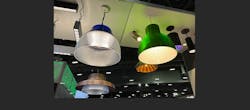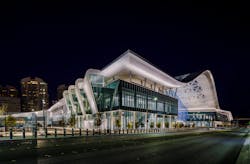The LightFair 2022 trade show and conference, held June 19-23 in Las Vegas, had more than 320 exhibitors and offered attendees 41 educational sessions. With estimated attendance of 10,000, booth traffic was decent and notably stronger than the 2021 LightFair event in New York, which struggled to overcome the required vaccine and mask mandates.
Several exhibitors at this year’s event said even though attendance was much lower than other LightFairs in the pre-COVID era, booth traffic was solid and (for most of the show) was at a “manageable level,” where they could have meaningful conversations with customers, rather than the quick meet-and-greets at more crowded events.
There was a lot of chatter on the show floor about the decisions by several large companies (including Acuity Brands, Lutron, MaxLite, and Ideal Industries’ Cree Lighting business unit) to not exhibit at the event. However, the roster of exhibitors on the show floor was a good representation of the major players in today’s lighting market, and there were plenty of new products for attendees to check out on the show floor. The show’s manager and sponsors — AMC, the Illuminating Engineering Society (IES), and International Association of Lighting Designers (IALD) — should be commended for staging a quality event despite major staffing cuts at the associations, the challenges all trade shows are facing in the post-COVID world, and sweeping consolidation in the lighting industry that has cut the number of potential exhibitors. Here are several observations from the show floor at LightFair 2022:
The tiers of lighting manufacturers looked more distinct than ever at LightFair 2022. In the lighting world, there’s a relatively small group of lighting manufacturers with annual revenues of more than $1 billion; a larger group of mid-sized players with revenues of between $100 million less than $1 billion; and smaller lighting vendors with annual revenues of less than $100 million. According to public documents, published articles, and other credible online sources, the members of the “billion-dollar club” include Signify, Acuity, LEDVANCE, and Current. The mid-sized lighting manufacturers include Lutron, Legrand, and the lighting product business units in Leviton at the high-end of the tier, as well as Ideal Industries Cree Lighting business, TCP, Maxlite, Halco, RAB Lighting, WAC Lighting, Nicor Lighting, and Keystone Lighting Solutions; and smaller lighting manufacturers including Earthtronics, Energy Focus, Tivoli Lighting, USAI Lighting, and Edison Price.
The lighting equipment manufacturers on the show floor – from the largest billion-dollar companies to the smallest specialty manufacturers – have access to most of the same LED semiconductor chips and fixture or control manufacturing/fabrication processes, so the name of the marketing game in the years to come will be how these large and small companies differentiate themselves in the market.
Brand ownership continue to evolve. In addition to dozens of other lighting brands on the show floor, EC&M counted 83 different lighting brands marketed by three of the largest lighting vendors – Signify (including the Cooper Lighting portfolio of brands); LEDVANCE; and Current (including brands purchased in the Hubbell Lighting acquisition). Many of these brands got their start as small independent companies that eventually became part of a larger lighting manufacturer’s product portfolio. After acquiring new lighting brands, new parent companies always must decide whether to invest the marketing dollars to maintain these brands or to promote their corporate identity. Brands live or die based on these decisions.
Look no further than GE Lighting’s journey of more than 100 years, from an iconic brand with roots in Thomas Edison’s original lamp business, to a prominent place in the GE portfolio companies, and more recently to its new identity as part of Current, which blends GE’s commercial/industrial lighting business with what was once Hubbell’s lighting division.
Marketing customizable white LEDs that enhances productivity and improves mental focus. Several vendors EC&M visited with at the show were working on tunable LED lighting that can be customized to specific applications, including classrooms and factories. There’s a lot of research into how certain types of lighting can increase students’ attention spans and help productivity/safety on the factory floor. The concept of tunable white light isn’t new, but manufacturers now have a new generation of LED chips that can be matched more accurately to specific applications and more insight into the impact of white LED light on health/well-being from an ever-growing body of research.
Grow, baby, grow. While programming LED chips to provide the unique lighting spectrum needed for marijuana in the cannabis industry gets all the ink, several manufacturers on the show floor were also marketing LED growth lights for other areas of the horticultural and farming verticals, including flowers, food crops, and urban farms, where plants are grown in multi-level buildings turned into greenhouses.
App-based lighting control. New app-based lighting controls launched at LightFair face competition from a dizzying array of established app-based controls. Many of them offer similar simple, intuitive programming from a smartphone. It’s pretty amazing to see how quickly these lighting control apps replaced much more complex lighting control systems that a few short years ago only lighting engineers could understand. While the march of technology is impressive, it’s fair to ask if the sheer number of app-based lighting controls now on the market will confuse designers and installers faced with differentiating all the new app-based systems from each other.
Covid rears its ugly head at the show. While attendees and exhibitors were delighted to be seeing old business friends in LightFair 2022’s mask-free environment, EdisonReport.com said at least 171 attendees reported testing positive for Covid at the show or shortly after returning home.
The RAB Lighting booth’s bold minimalist approach. RAB Lighting’s booth, which had no products on display and nothing more than two giant melting ice cubes suspended from the convention hall's rafters, was the most talked-about booth at the show. An RAB Lighting spokesperson told EC&M the melting ice cubes were intended to represent global warming, and how the company's lighting portfolio offers solutions to enhance sustainability on the planet.
And the winner is… On the first day of the show, LightFair announced the winners of its 2022 LightFair Innovation Awards (LIAs) in 14 categories, along with four overall excellence distinctions: Most Innovative Product of the Year (MIFOR 70 Lighting System by Klus); Technical Innovation (TruBlu Bluetooth Mesh Fixture Controller with Long Range Antenna by McWong International); Design Excellence (Easy-Link by Edison Price Lighting); and Judges’ Citation (CombiCable by Gripple) awards.
The National Lighting Bureau’s (NLB) Tesla Awards were also announced at LightFair. These awards honor projects that promote health and wellness, productivity, safety and security, visual comfort, control of light pollution, retail/commercial performance, and entertainment. This year’s Tesla Award winners are: 800 W Fulton — Schuler Shook; Biân – Morlights; Expedia Group Headquarters — Fisher Marantz Stone; LA Metro Willowbrook/Rosa Parks Station Improvements – Stantec; The Daxton Hotel – Morlights; and Rotes Rathaus Subway Station Line 5 — Licht Kunst Licht.
Special citations in NLB’s Tesla Awards program were also given to Little Island — Fisher Marantz Stone; Luminous Ceilings — Schuler Shook; Steppenwolf Theatre — Liz and Eric Lefkofsky Arts and Education Center — Morlights. Honorable mentions included Academy Museum of Motion Pictures — BurroHappold and Fisher Marantz Stone; Midway Airport Security Checkpoint Expansion — Schuler Shook; and Oberpollinger — Licht Kunst Licht.
Next year’s LightFair will be held at New York's Javits Center, May 21-25, 2023.
About the Author
Jim Lucy
Editor-in-Chief of Electrical Wholesaling and Electrical Marketing
Jim Lucy has been wandering through the electrical market for more than 40 years, most of the time as an editor for Electrical Wholesaling and Electrical Marketing newsletter, and as a contributing writer for EC&M magazine During that time he and the editorial team for the publications have won numerous national awards for their coverage of the electrical business. He showed an early interest in electricity, when as a youth he had an idea for a hot dog cooker. Unfortunately, the first crude prototype malfunctioned and the arc nearly blew him out of his parents' basement.
Before becoming an editor for Electrical Wholesaling and Electrical Marketing, he earned a BA degree in journalism and a MA in communications from Glassboro State College, Glassboro, NJ., which is formerly best known as the site of the 1967 summit meeting between President Lyndon Johnson and Russian Premier Aleksei Nikolayevich Kosygin, and now best known as the New Jersey state college that changed its name in 1992 to Rowan University because of a generous $100 million donation by N.J. zillionaire industrialist Henry Rowan. Jim is a Brooklyn-born Jersey Guy happily transplanted with his wife and three sons in the fertile plains of Kansas for the past 30 years.


